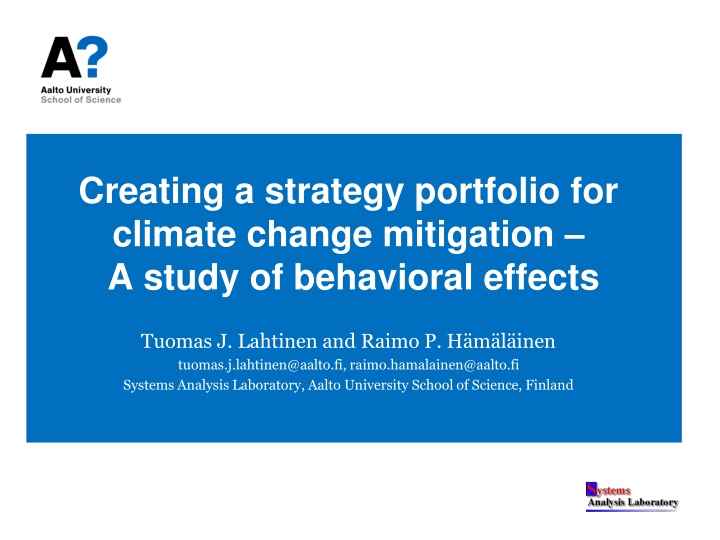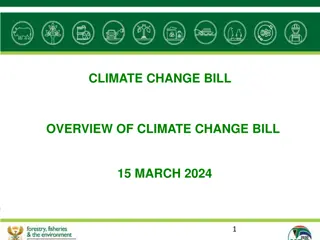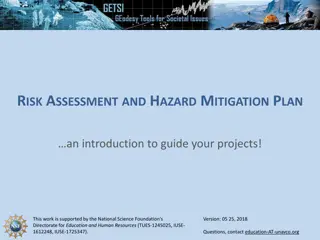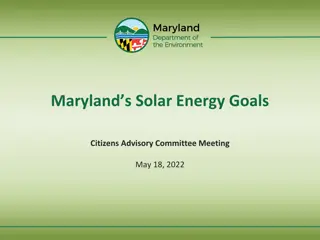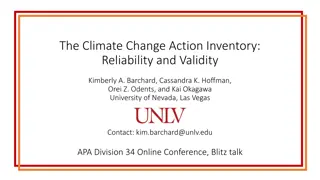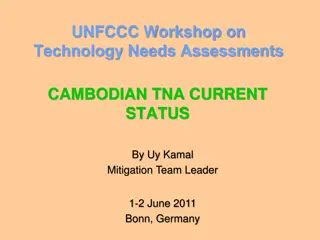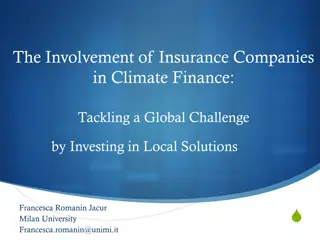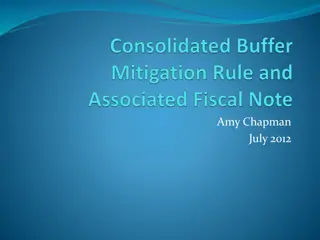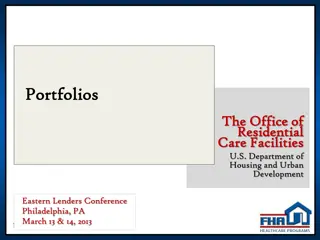Creating a Strategy Portfolio for Climate Change Mitigation
This study examines behavioral effects on environmental management decisions and explores the generation of multi-criteria portfolio approaches for addressing climate change. The research focuses on identifying the best basket of actions for stakeholders to achieve environmental, societal, and economic objectives while considering budget, time, and resource constraints. Behavioral issues in portfolio generation, including heuristics and biases, are discussed to enhance decision-making processes.
Download Presentation

Please find below an Image/Link to download the presentation.
The content on the website is provided AS IS for your information and personal use only. It may not be sold, licensed, or shared on other websites without obtaining consent from the author.If you encounter any issues during the download, it is possible that the publisher has removed the file from their server.
You are allowed to download the files provided on this website for personal or commercial use, subject to the condition that they are used lawfully. All files are the property of their respective owners.
The content on the website is provided AS IS for your information and personal use only. It may not be sold, licensed, or shared on other websites without obtaining consent from the author.
E N D
Presentation Transcript
Creating a strategy portfolio for climate change mitigation A study of behavioral effects Tuomas J. Lahtinen and Raimo P. H m l inen tuomas.j.lahtinen@aalto.fi, raimo.hamalainen@aalto.fi Systems Analysis Laboratory, Aalto University School of Science, Finland The document can be stored and made available to the public on the open internet pages of Aalto University. All other rights are reserved.
Environmental management decisions are portfolio problems Find the best basket (portfolio) of actions Stakeholder perspectives Environmental, societal and economical objectives The overall consequences matter Actions complement each other Actions have dependencies and synergies Budget, time and resource constraints The portfolio perspective is needed (Lahtinen, H m l inen, Liesi 2017a)
Example: Climate Stabilization Wedges Game, Princeton
To keep carbon emissions on todays level we need to create a basket of 8 emission reduction strategies Billions of Tons Carbon Emitted per Year 15 strategy candidates 16 Historical emissions 8 Goal: Flat path 1.6 1950 2050 2000 Year
Multi-criteria portfolio generation approaches Unaided generation of portfolio alternatives without modelling or optimization support Followed by MCDA evaluation of the portfolio alternatives Common approach because of soft criteria and aspects that are difficult to measure Benefit-cost approach Portfolio decision analysis approach Heuristic optimization approach Behavioral issues in portfolio approaches need attention there are new phenomena not discussed in MCDA Result can be a sub-optimal or non-dominated portfolio
Behavioral issues in unaided portfolio generation Portfolios generated in a step-by-step process Path dependence (H m l inen and Lahtinen 2016, Lahtinen et al. 2017a,b) the order in which the actions are considered has an impact Behavioural drivers (see, e.g. Fasolo, Morton, von Winterfeldt 2011) Heuristics and biases Narrow thinking See also H m l inen et al. 2013, H m l inen 2015
Different approaches can trigger different heuristics and biases Elimination by aspects: eliminate actions below a treshold in a criterion (Tversky 1972) Equal allocation of resources to categories (Benarzi and Thaler 2001) Loss aversion: Adding a costly action to the portfolio causes a loss of money, removing a costly action saves money (Kahneman and Tversky 1991) Approach and avoidance conflict: A choice between two undesirable outcomes can be very difficult to make (see, e.g. Terry 2010) Premature commitment to actions that first come to mind
Narrow thinking Individual actions considered in isolation of the big picture (Tversky and Kahneman 1985, Read et al. 1999) Double counting benefits or costs Not seeing that actions interact and complement each other Affective decision making and insensitivity to scope (Loewenstein and Lerner 2003, Kahneman et al. 1999) Costly actions with small impacts may get selected
MCDA The standard approach Alternatives = portfolios of actions Alternative A Alternative B Alternative C Multiple objectives Ranking of alternatives Value compositions Objective 1 1 2 3 1 5 7 Objective 2 3 4 5 MCDA value model Objective 3 A B C ? ? = Evaluation of portfolios of actions generated in an unaided process Behavioral issues: Generation of alternatives Behavioral effects in MCDA
Simple benefit-cost approach MCDA evaluation of individual actions synergies and interactions not considered Portfolio generation: Include the actions in the highest benefit-cost ratio order See, e.g. Kleinmuntz 2007, Hajkowicz et al. 2008 Behavioral issues: Narrow thinking: Omission of synergies and interactions Behavioral effects in MCDA
Portfolio Decision Analysis (PDA) MCDA value model + constraints + optimization Includes interactive value modeling Synergies and interactions can be modeled using the constraints Behavioural issues: Ranges become problematic! Are weights based on consequences of individual actions or overall consequences of (feasible) portfolios of actions? Behavioral effects in MCDA
Heuristic optimization approach Used extensively in conservation network design (see, e.g. Moilanen 2007, Lehtom ki and Moilanen 2013) The overall value model can include synergies and non- linearities Start with all areas of land Remove the area with the smallest loss of overall value until feasible solution is found Behavioural issues: Biases in creating the optimization criterion Early commitment to suboptimal solution? Beauty effect a complicated model can become an unquestioned authority?
Behavioural experiment on the web carbcut.aalto.fi Based on the Climate Stabilization Wedge Game Original CMI s message: We already have the technology needed for climate change mitigation The problem is to choose the desired strategies Our experimental treatments: Two procedures for creating the preferred portfolio of emission reduction strategies Adding strategies into the basket Removing extra strategies from the basket
Adding procedure Starting point: Empty basket Result: 8 strategies in the basket 5 1 2 8 Basket 3 13 12 11 Choices can be affected by biases and heuristics 5 1 2 8 10 14 6 6 3 4 Strategies 7 4 7 10 15 9 13 12 11 14 9 15
Removing procedure Starting point: Extra strategies in the basket Result: 8 strategies in the basket 5 1 2 8 5 1 2 8 Basket 6 3 4 7 3 10 10 9 13 14 12 11 14 12 15 Choices can be affected by biases and heuristics 11 13 6 Strategies 4 7 15 9
Questions of interest Does the result depend on the procedure followed? If yes, can the result be explained by heuristics or biases such as elimination by aspects or loss aversion? Adding a costly action causes loss of money Removing a costly action saves money Is one procedure more prone to trigger biases or non- systemic thinking? Is one procedure perceived easier? Does the result reflect the approach / avoidance conflict? People do not like choosing between undesirable options Is there a tendency to prefer the result obtained with either one of the procedures?
How do the subjects choose their paths? What perspectives are considered (costs, feasibility, sustainability, balance, fairness)? Do the subjects use the possibility to backtrack? Are the subjects more likely to select strategies shown first in the list? Do the subjects make modifications to the completed portfolios? Do the subjects prefer portfolios in which they have made modifications? Does either procedure lead to modifications more often?
Similarity: the number of same strategies in the two portfolios created How do the respondents backgrounds correlate with i) the strategies chosen and ii) similarity of the portfolios created? Background data: Field of study, age, gender, professional / student How do the perspectives considered correlate with similarity? How does perceived difficulty of using the procedures correlate with similarity? How does the number of steps taken correlate with similarity?
Results Number of subjects Avg. Similarity (max is 8) # Full similarity Similarity measure: the number of same strategies in the two portfolios created Add Remove P-value Avg. # dollars Avg. # steps taken Min. # steps taken Max. # steps taken Difficulty evaluation Preferred result
How many participants chose the actions Add Remove
Ideas for bias mitigation Applying the path perspective (Lahtinen et al. 2016) Follow multiple paths and compare the results Use intermediate checkpoints Training decision makers to avoid biases Does not always work, e.g. did not help to avoid the splitting bias (H m l inen and Alaja 2008) Not studied in portfolio decision making? Use portfolio modeling approaches Can mitigate path dependence and narrow thinking but may bring in other biases
Checking procedure Result: 8 strategies in the basket 5 1 2 8 Check if a strategy swap improves the basket? 3 13 12 11 14 6 4 7 15 10 9
Conclusions for environmental policy analysts Behavioral research on environmental portfolio problems is very limited but important The most significant environmental issues faced by mankind are portfolio problems, e.g. climate policy We need to pay attention to the decision processes when creating climate policy There can be unanticipated phenomena related to the systemic nature of the problem Portfolio thinking is needed to mitigate path dependence and narrow thinking Portfolio modeling can help? All actions and relevant interactions included simultaneously in the same model
Conclusions for decision analysts The generation of alternatives is studied very little from the behavioral perspective Portfolio generation is often an implicit part of alternative generation What is the role of path dependence, cognitive biases and heuristics? Methods for portfolio decision analysis are promising but coping with behavioral effects and synergies is still difficult How to mitigate biases? How to support problem framing and identification of synergies? Limited software support for handling synergies
References and links Benartzi, S. and Thaler, R.H., 2001. Naive diversification strategies in defined contribution saving plans. American economic review, 91(1), 79-98. Fasolo, B., Morton, A., von Winterfeldt, D., 2011. Behavioural issues in portfolio decision analysis. In: Salo, A., Keisler, J.M., Morton, A. (Eds.), Portfolio DecisionAnalysis. Springer, pp. 149-165. Hajkowicz, S., Spencer, R., Higgins, A., & Marinoni, O. 2008. Evaluating water quality investments using cost utility analysis. Journal of Environmental Management, 88(4), 1601-1610. H m l inen, R.P., Alaja, S. 2008. The Threat of Weighting Biases in Environmental Decision Analysis Ecological Economics, Vol. 68, 2008, pp. 556-569. H m l inen, R.P., Luoma, J., and Saarinen, E. 2013. On the Importance of Behavioral Operational Research: The Case of Understanding and Communicating about Dynamic Systems European Journal of Operational Research, 228, 3: 623-634. H m l inen, R.P. 2015. Behavioural issues in environmental modelling - the missing perspective Environmental Modelling & Software, 73, 244-253. H m l inen R.P., and Lahtinen, T.J. 2016. Path Dependence in Operational Research How the Modeling Process Can Influence the Results Operations Research Perspectives, 3:14-20. Kahneman D, Ritov I, Schkade D. 1999. Economic preferences or attitude expressions?: An analysis of dollar responses to public issues. Journal of Risk and Uncertainty,19(1 3):203 35. Kleinmuntz, D.N., 2007. Resource allocation decisions. In: Advances in Decision Analysis: from Foundations to Applications. Cambridge University Press, pp. 400-418. Lahtinen, T. J., H m l inen, R. P. and Liesi J. 2017a. Portfolio Decision Analysis Methods in Environmental Decision Making Environmental Modelling and Software, 94, 73-86 Lahtinen, T.J., Guillaume, J.H., Ham l inen, R.P., 2017b. Why pay attention to paths in the practice of environmental modelling? Environ. Model. Softw. 92, 74-81. Lahtinen T.J., H m l inen R.P., Jenytin C., 2017c. A systems perspective on bias mitigation in decision analysis. Manuscript available on request.
Lehtomki, J. and Moilanen, A., 2013. Methods and workflow for spatial conservation prioritization using Zonation. Environmental Modelling & Software, 47, 28-137 Loewenstein, G., and Lerner, J. 2003. The role of affect in decision making. In R. J. Davidson, H. H. Goldsmith, & K. R. Scherer (Eds.), The handbook of affective science. Oxford, England: Oxford University Press Moilanen, A., 2007. Landscape zonation, benefit functions and target-based planning: unifying reserve selection strategies. Biol. Conserv. 134 (4), 571-579. Read, D., Loewenstein, G., Rabin, M., Keren, G. and Laibson, D., 1999. Choice bracketing. Journal of Risk and Uncertainty, 19:1-3; 171-197. Salo, A., Keisler, J. and Morton, A. (Eds.), 2011. Portfolio decision analysis: improved methods for resource allocation. Springer. Thaler, R. H., and Sunstein, C. R. 2008. Nudge: Improving decisions about health, wealth, and happiness. New Haven, CT: Yale University Press. Thaler, R. H., Sunstein, C. R., and Balz, J. P. 2014. Choice architecture. In E. Shafir (Ed.), Behavioral foundations of public policy: 428-439. Princeton, NJ: Princeton University Press. Tversky, A., 1972. Elimination by aspects: A theory of choice. Psychological review, 79(4), 281. Tversky, A. and Kahneman, D., 1985. The framing of decisions and the psychology of choice. Science, 211, 453-458. Tversky, A. and Kahneman, D., 1991. Loss aversion in riskless choice: A reference-dependent model. The quarterly journal of economics, 106(4), pp.1039-1061.
